Weight loss advice has been muddled for decades now.
For example, in the 90’s, we were told that all we had to do to get the body of our dreams is eat as little dietary fat as possible.
Now we’re being told we can eat a snootful of fat every day so long as we restrict our carbohydrate and sugar intake.
Hormones…artificial sweeteners…chemicals and “toxins”…genetically modified foods…wheat and gluten…they’re all to blame for our collective fatness, according to one “guru” or another.
And the weight loss solutions they offer?
Restrictive dieting, of course, which, in many cases, means facing down a short list of what you can eat with everything else being strictly verboten.
Ironically, and fortunately for you, they’re all missing the forest for the trees.
You see, losing weight is much simpler than you’ve been led to believe, and in this article, we’re going to talk about a weight loss and maintenance strategy that not only makes sense and is supported by good science, but actually works in the real world: portion control.
The reason portion control works is simple. It strikes at the heart of why our weight changes for better or worse, which is the fact the quantity, not quality, of the food we eat matters most.
Yes, when we’re talking weight, what we eat matters much less than how much.
Couple that with the fact that people’s overall food portion sizes keep getting bigger, leading them to passively eat more and more calories, and it’s no wonder that obesity rates are rising faster than a Viagra erection.
Research shows that portion size is one of the strongest environmental factors contributing to weight gain, and by the end of this article, you’re going to know why, how it works, and how to use it as a tool for not just losing weight but preventing unwanted weight gain as well.
Let’s get started.
- Why Portion Control Matters
- Why Do We "Accidentally" Overeat?
- How to Use Portion Control to Lose Weight for Good
- The Bottom Line on Portion Control
Table of Contents
+Want to listen to more stuff like this? Check out my podcast!
Why Portion Control Matters
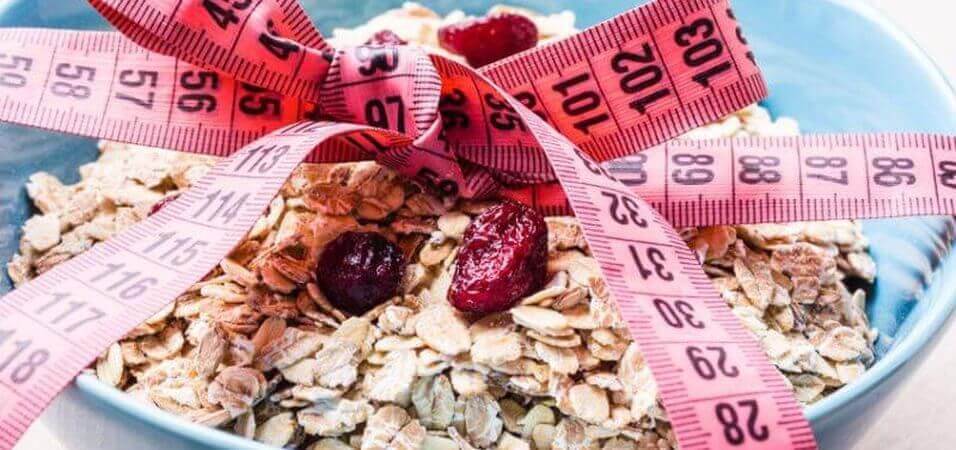
At bottom, portion control matters because how much you eat, as measured in calories, matters. A lot.
The overarching mechanism in play here is energy balance, which is the relationship between the amount of energy you consume and burn.
The unit of measurement we use to discuss energy balance is the calorie, which is the amount of energy required to heat one kilogram of water one degree Celsius.
Energy balance is a vital concept to understand because it alone determines how your body weight changes in response to the food you eat (and thus how many calories you should be eating).
You see, if we climb over the magazine shelves and pill and powder hucksters to get a clearer view of the scientific literature, we quickly learn two things:
- You have to burn more energy than you consume to achieve meaningful weight loss.
- You have to consume more energy than you burn to achieve meaningful weight gain (both fat and muscle).
Now, if you’re tempted to scroll up to top of this article to see if it was written a decade ago, suspend your disbelief for a moment and bear with me.
First, consider the fact that bodybuilders have used these scientific principles for decades now to systematically increase and reduce body fat levels.
Then, if you’re feeling frisky, peruse the last century of metabolic research and you’ll find that every every single well-designed weight-loss study…including numerous meta-analyses and systematic reviews…has determined that we have to expend more energy than we ingest to achieve meaningful weight loss.
And let’s not forget that every year a new fad diets that deny the importance of energy balance pop up, and time after time they fail to gain scientific acceptance and eventually disappear.
The bottom line is this:
100 years of metabolic research has proven beyond question that energy balance, operating according to the first law of thermodynamics, is the primary mechanism that regulates body weight.
That doesn’t mean you have to count calories to lose weight, but you do have to understand the relationship between caloric intake and expenditure and weight gain and loss.
With that out of the way, let’s get back on topic.
Multiple studies spanning decades have proven the link between large portions, overeating, and obesity.
Basically, the larger the portions of food you’re generally served or serve yourself, the more likely you are to eat too much and gain weight.
Thanks to what researchers refer to as a “mindless margin,” it’s very easy to slightly under- or over-eat without realizing it (and by “slightly,” we’re looking at 15 to 20% per meal).
To put it in perspective, let’s say you burn about 2,000 calories per day, which is what you’d have to eat to maintain your weight.
If you overate by just 15% every day (about 300 calories more), you’d be faced with about 30 pounds of weight gain by the end of the year…without feeling like you had been overeating at all.
Now, if you think that this is unlikely in the real world — that our bodies are better at auto-regulating the amount of food we feel compelled to eat, think again.
Multiple studies have proven that people do consume more calories overall when offered larger portions, even when they’re not hungry and, better, even when the food tastes bad.
If outsized portions are put in front of us every day, we’ll happily eat it all, never compensating by eating less on the whole.
Combine this inability to self-regulate with our mindless margin tendencies, and you’ve got a recipe for sustained weight gain and even obesity.
Luckily, the reverse is also true. When we learn to rightsize our portions, we consume fewer calories, which is why portion control is so important.
Once you understand how to control your food portions and have a heightened awareness of how many calories you eat and burn, you can control your body weight with ease.
Now, if you’re afraid that we’re getting to the part about half-empty plates with quarter-sized dollops of food, fear not.
As you’ll see, portion control is about much more than just eating less of everything. It’s about understanding the quantitative differences in the kinds of foods and drinks you’re choosing and adjusting intake accordingly.
Let’s break it down piece by piece.
Why Do We “Accidentally” Overeat?
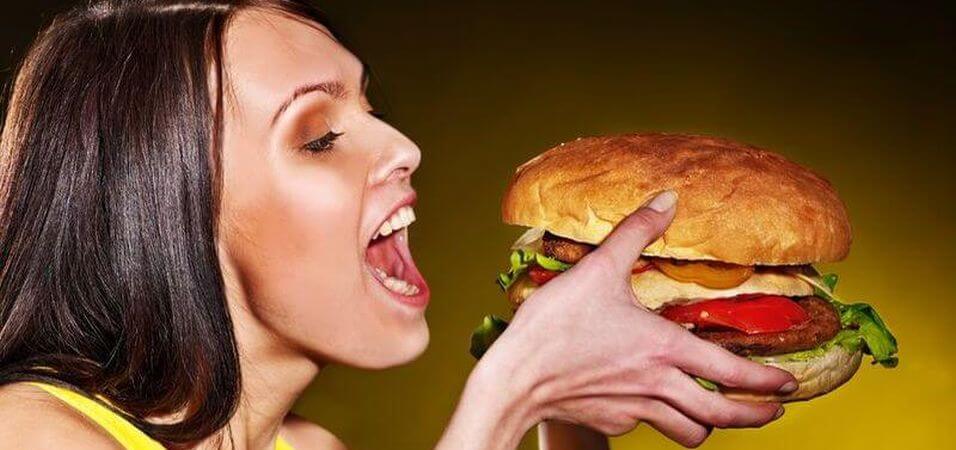
Simple question, right?
We overeat because we’re just hungry, right?
Nope.
Actual physiological hunger (and its opposite, satiety) plays a pretty small role in how much food we eat.
This is why weight loss and maintenance strategies centered around just blunting or controlling hunger rarely work.
Instead, research shows that a mix of external factors, internal cues, and social signals are collectively corrupting our eating instincts.
Environmental Factors and Overeating
Our eating habits are heavily influenced by our environment.
Here are three of the bigger factors:
1. Packaging
Portion sizes have been on the rise for decades, and this is most obvious in food packaging.
Ever notice the tiny bags of chips near grocery store checkouts? They usually cost a dollar or so and contain the standard one-ounce serving of potato chips.
Don’t they just look impossibly small? They seem like the right choice for your kid’s lunch box, but not for you!
Compare those to what you see on the displays at convenience stores. The “super grab bag” has taken over as the norm for portion size of chips.
There’s the “value sized” candy bars and cereal boxes, and it’s getting harder to find 12oz cans of soda and 8oz energy drinks now — both have been replaced by larger bottles and cans.
Constant exposure to these larger portion sizes has led to what researchers call “portion distortion” among consumers.
That is, we tend to assume that the entire package of a food or drink is the “right size,” and we psychologically prime ourselves to eat and drink it all in one go.
2. Dining Out
Many dieters feel that they can make the right portion choices at home, but overeat greatly when dining out.
There’s truth here.
Restaurants tend to vastly over-serve, which makes it really easy to eat egregious amounts of calories.
Case in point:
A study conducted by scientists at Tufts University involved the analysis of 360 dinner entrees at 123 non-chain restaurants in San Francisco, Boston, and Little Rock between 2011 and 2014.
They found that the restaurant dishes contained, on average, about 1,200 calories, and that American, Italian, and Chinese restaurants were the worst offenders, with an average of nearly 1,500 calories per meal.
Calorically speaking, there’s not much of a difference between fast food and full-service dining.
Even more flagrant offenders can be found in a 2014 analysis of restaurant foods from the Center for Science in the Public Interest.
The Cheesecake Factory, for example, makes a “bruléed French toast” with a side of bacon that weighs in at 2,780 calories, 93 grams of saturated fat, and 24 teaspoons of sugar. They also offer a creamy farfalle pasta with chicken and roasted garlic, which is a bit lighter at just 2,410 calories and 63 grams of saturated fat.
Let’s also not forget that those are just individual entrees, which, for many people, aren’t the entirety of their meals. Add in some bread, an appetizer, and a bit of dessert, and you’re looking at a cheat meal of horrific proportions.
Not unlike retail packaging, there’s a lot of “portion distortion” going on here. The more we’re served, the more we eat.
Why are the restaurant dons doing this to us? Do they just want us all to be forever fat?
Alas, we can only blame ourselves for this trend. Too many diners care too much about food quantity over quality, and, well, we’ve reaped the whirlwind.
To see this in action, head over to Yelp and find a high-end, fine-dining restaurant. Ideally, one that specializes in small plates, tapas, or other decorative presentations of food.
Take a look at the 1-star reviews. I’m certain there’s at least one person griping about how the portion sizes were rip-offs.
(Really? How much freaking pork belly do you need to slingshot into your facehole to be satisfied??)
Now imagine if a restaurant like Olive Garden did the same thing.
Your waiter walks up to your table and hands you a perfectly-portioned 2-ounce serving of pasta with a ½ cup of sauce on top. Oh, and just because this meal is so calorically balanced, let’s throw in a bit of a breadstick for you to enjoy, too!
Jaws would drop. Bills would be left unpaid. Locations would wind up boarded up and vandalized.
My point is we’ve come to expect jumbo portions and happily eat them.
3. Distractions
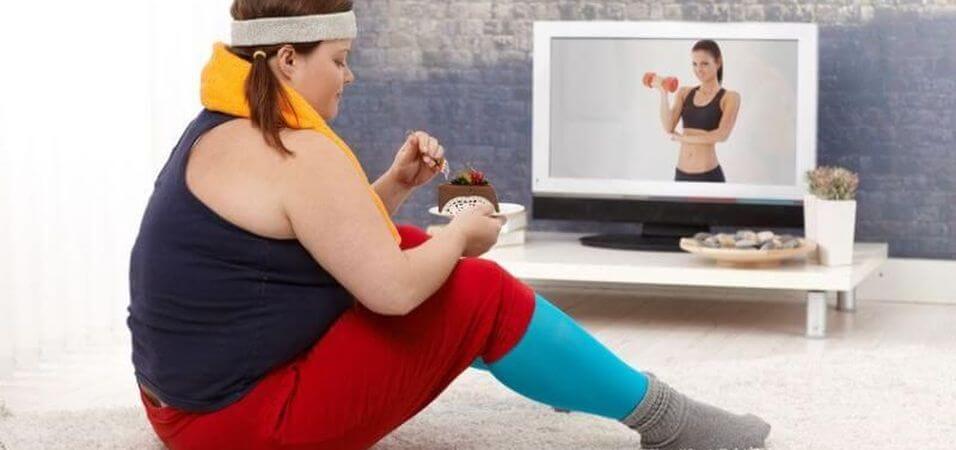
Whether you’re dining out or eating in, distractions can lead to overeating.
TV, dining companions, and video games are the most common culprits.
You see, when you’re focused on something besides your dinner plate, you spend less time processing the actual eating experience.
By engaging in conversation or getting caught up in TV drama, you’re too distracted to think about the way you feel while eating.
To make it worse, we also often forget what we’ve just eaten when we’re distracted, so maybe just an hour after eating a pizza in front of the TV, you see commercial for your favorite nibbles, and back you go to the kitchen for another snack.
The solution here is to be more mindful when you eat.
Slow down, focus your attention on the sensory details — taste, texture, smell, sound — and your internal barometer of fullness. Try to enjoy every bite and stop when you’re satisfied, not stuffed, and you’ll become a much better eater.
Internal Sensory Cues and Overeating
Actual physiological hunger (as opposed to mental yearnings and cravings) may not be a big contributor to our overeating, but there are plenty of other internal cues that are.
For example, the anticipation of food conjures up all kinds of vivid images of how a meal is going to smell or taste.
This is a food’s palatability — its complex mix of smell, texture, temperature, and even sound produced while eating. And the more delicious food you have around, the more primed you’re going to be to have titillating thoughts about it.
These thoughts make us think we’re hungry even when we’re not, making it harder to know when we’re actually eating to satisfy a physiological need.
This is why imagining the pleasure of eating is enough to make us forget about our diets and head for the freshly-baked cookie or bag of crispy Cheetos.
Social standards are another powerful internal cue for eating.
If you’re in the US, you’re surely aware that calories don’t count on Thanksgiving Day. Or Super Bowl Sunday. Or the day your favorite college team plays. Or….
There’s no shortage of days in which we’re “allowed” to fire hose food down into our faces.
But why?
Well, we seem to always be able to make room for more food when it seems “normal” to do so.
Without a firm grasp on how servings relate to calories and how caloric intake relates to weight, the amount we feel we should eat in a given situation fluctuates depending on what we perceive to be typical or acceptable.
For example, research shows that we tend to think about how much we’ve served in the past, what quantity we usually buy, or how much we have on hand. We also look to the behavior of our dining companions and often imitate their eating habits.
Notice that we don’t really think about how hungry we are — just about what seems like the right amount.
How to Use Portion Control to Lose Weight for Good
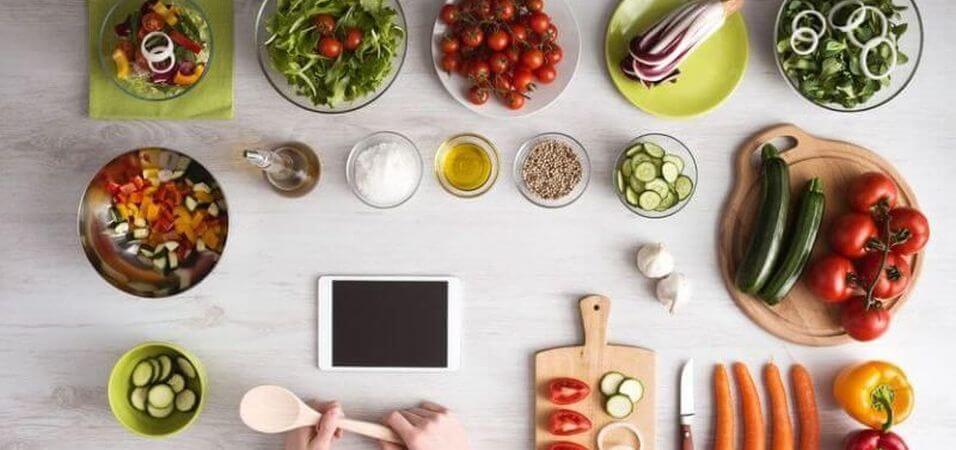
It’s not very practical to just tell someone to “eat less” when eating large portions of everything is so ingrained.
Studies show that we naturally want to eat the same amount of food by weight each day, so trying to simply slash that in half is probably going to leave you with an appetite like a chainsaw.
Instead, you can satisfy both your need for food volume and calorie control by increasing your portions of certain foods while reducing others.
Basically, by making smart substitutions, you can eat more or less the same amount of food for a lot less calories, and that will help you maintain a more desirable body weight.
For example, if you load your plate with low-calorie, high-fiber, high-water foods like fruits and vegetables, it’s going to be filling but far lighter than meats, grains, and starches.
And if you give the least space on your plate to calorie-dense foods high in fats and/or sugars, that too helps tremendously.
So, let’s take a closer look at how to get your portions working for you, both at home and out on the town.
How to Control Your Portions at Home
If most of your meals are prepped or eaten at home, you’ll want to make your kitchen portion-control-friendly.
The first step is learning what appropriate portion sizes of various foods are, and to do this, you’ll need just three things:
1. Measuring cups and a food scale.
See if you can correctly eyeball a cup of oatmeal or a couple table spoons of peanut butter without them. It’s not easy!
2. A calorie counting website like Calorie King or Calorie Count.
You’re probably going to be surprised how many calories your favorite foods have per serving.
3. An understanding of approximately how many calories you’re burning every day.
This is the linchpin, really. If you have no clue as to your energy expenditure, you have no clue as to how much you can or should be eating, regardless of portion sizes.
(Should you eat two or three ounces of pasta at dinner? 1 or 2 pieces of toast at breakfast? Two or three scoops of protein powder after working out?)
Now, don’t worry, you won’t have to measure and track everything you eat for the rest of your life.
This is just the quickest and easiest way to get a handle on your portions because, within a few weeks of trial and error, you’ll have a good sense of how much or little of everything you should be eating.
This approach is also better than following generalized portion guidelines based on hand or fist size or plate apportioning because it’s more accurate and allows you to make good eating decisions on the fly.
You might also want to rethink your dinnerware as well, which includes your plates, bowls, glasses, and silverware, because larger dinnerware generally leads to eating larger portions,
If you drink caloric beverages (bad idea, by the way), the same applies to glassware: we tend to pour larger portions into shorter, wider glasses than into taller, narrow glasses.
Here are some other easy wins:
- Pre-plate your main entrees, starches, and grains in the kitchen before heading to the table.
- Serve salads, vegetables, and fruit family-style at the table so that you take more.
- Never eat foods out of the package unless you plan on eating the entire lot. If not, transfer a snack to a plate or bowl instead.
- Pre-measure dinner portions in advance (like in meal prepping). Put away the leftovers before you eat your portion.
- Pre-measure out single-serving bags or containers of snacks like nuts and chips.
- Keep tempting snacks like chips, cookies, and cereal boxes in cabinets and off the counters.
How to Control Your Portions at Restaurants
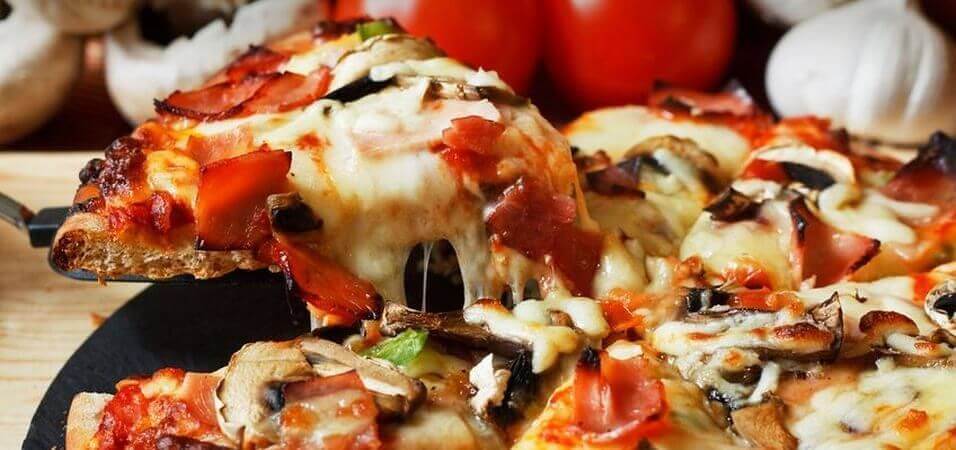
Don’t worry — I’m not going to tell you to pack your food scale on your next trip to your favorite food haunt.
Instead, you’re going to take what you’re learning at home and apply it to dining out.
That is, you’re going to want to stay away from super-sized portions, stick mainly to lower-calorie foods and limit your intake of high-calorie ones, and so forth.
Here are a few tips that will help:
- Ignore the allure of the “value size” option, especially at a fast food restaurant.
- Order the smallest size offered.
- Decide in advance to take half of your meal home for leftovers.
- Share with a friend.
- Decline the side that comes with your entrée (especially if you can’t get a lower calorie option).
- Eat an appetizer or two as your main course. These are often perfectly entrée-sized!
The Bottom Line on Portion Control
Those of us that want to eat responsibly are up against a lot.
Cues to eat are everywhere, making it all too easy to overeat, and until there’s a systemic shift in food marketing and general food awareness, our dietary fate is squarely in our hands.
Good portion control skills give us a major advantage. They allow us to control our calories without having to be too neurotic about what goes onto our plates and into our mouths.
Just because it’s simple doesn’t mean it will come quickly, though. It may take time to “unlearn” your bad habits and tune out and ultimately disarm the external and internal triggers that conspire against us.
Once you’ve got it, though, and have honed your eye and instincts for rightsizing your portions, buying, ordering, and cooking decisions get a whole lot easier.
What’s your take on portion control? Have anything else to share? Let me know in the comments below!
Scientific References +
- Wansink B, Chandon P. Slim by design: Redirecting the accidental drivers of mindless overeating. J Consum Psychol. 2014;24(3):413-431. doi:10.1016/j.jcps.2014.03.006
- Rolls BJ. What is the role of portion control in weight management. In: International Journal of Obesity. Vol 38. Nature Publishing Group; 2014:S1-8. doi:10.1038/ijo.2014.82
- An R. Fast-food and full-service restaurant consumption and daily energy and nutrient intakes in US adults. Eur J Clin Nutr. 2016;70(1):97-103. doi:10.1038/ejcn.2015.104
- Urban LE, Weber JL, Heyman MB, et al. Energy Contents of Frequently Ordered Restaurant Meals and Comparison with Human Energy Requirements and US Department of Agriculture Database Information: A Multisite Randomized Study. J Acad Nutr Diet. 2016;116(4):590-598.e6. doi:10.1016/j.jand.2015.11.009
- Steenhuis IHM, Vermeer WM. Portion size: Review and framework for interventions. Int J Behav Nutr Phys Act. 2009;6(1):58. doi:10.1186/1479-5868-6-58
- Rolls BJ. What is the role of portion control in weight management. In: International Journal of Obesity. Vol 38. Nature Publishing Group; 2014:S1-8. doi:10.1038/ijo.2014.82
- Rolls BJ, Roe LS, Meengs JS. The effect of large portion sizes on energy intake is sustained for 11 days. Obesity. 2007;15(6):1535-1543. doi:10.1038/oby.2007.182
- Steenhuis IHM, Vermeer WM. Portion size: Review and framework for interventions. Int J Behav Nutr Phys Act. 2009;6(1):58. doi:10.1186/1479-5868-6-58
- Rolls BJ. What is the role of portion control in weight management. In: International Journal of Obesity. Vol 38. Nature Publishing Group; 2014:S1-8. doi:10.1038/ijo.2014.82
- Wansink B, Chandon P. Slim by design: Redirecting the accidental drivers of mindless overeating. J Consum Psychol. 2014;24(3):413-431. doi:10.1016/j.jcps.2014.03.006
- Rolls BJ. What is the role of portion control in weight management. In: International Journal of Obesity. Vol 38. Nature Publishing Group; 2014:S1-8. doi:10.1038/ijo.2014.82
- Energy Balance and Obesity, Healthy Weight Basics, NHLBI, NIH. https://www.nhlbi.nih.gov/health/educational/wecan/healthy-weight-basics/balance.htm. Accessed April 1, 2020.
- Steenhuis IHM, Vermeer WM. Portion size: Review and framework for interventions. Int J Behav Nutr Phys Act. 2009;6(1):58. doi:10.1186/1479-5868-6-58
- Finkelstein EA, Khavjou OA, Thompson H, et al. Obesity and severe obesity forecasts through 2030. Am J Prev Med. 2012;42(6):563-570. doi:10.1016/j.amepre.2011.10.026










